They Could Hear A Faraway Thunder Analysis
Jorma Puranen's exhibition, 'They could hear a faraway thunder', gives new life to landscape photography. The pictures were installed on the white walls of the Anhava gallery which created contrast between the works and the walls, emphasising the art pieces. Viewing his works, the observer is enveloped in these frigid alien-like landscapes, and if they stare for too long, the Arctic cold might pierce their souls. The pictures, being landscapes are very much tied to space, and in this case, it is the Arctic. To a modern person, the Arctic symbolises a lot of things; wildness, the unknown, aurora borealis, Santa, etc, but the main one is climate change. This leviathan of our time is the focus of this exhibition, alongside colonial history and Arctic exploration. The Earth is changing and life in the Arctic is changing with it. Even the title alludes to this change, it is a quote from a poem by a Greenlandic poet and human rights activist, Aqqaluk Lynge, on caribou hunting in the past. Before the arrival of the caribou herds, people could sometimes hear something akin to faraway thunder. Now the East Greenlandic caribou has gone extinct and this faraway thunder has taken a new quality.
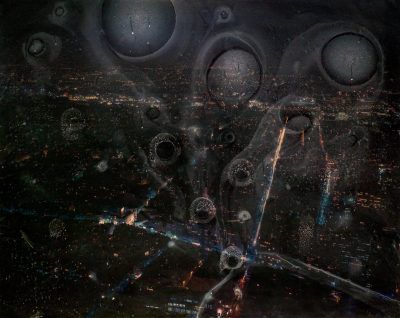
Paris doesn't answer, 2023
archival pigment print, glass, wooden frame
144 x 179 cm
Jorma attempts to show this uncertainty and unease with his multi-layered pictures sourced from archives. He experiments with pigments, dust, scratches, etc, to create photographs that make the observer feel the Arctic cold wearing away their bones. One of the photos that speaks to me is 'Paris doesn't answer'. It is the only picture in the exhibition that is not a natural landscape. Puranen says it is inspired by Fred Hoyle's 1996 sci-fi novel, but to me, it sings a different tune. The Paris Climate Accords came into effect 6 years ago, and yet here we are, with Jorma making an exhibition of the fragility and degradation of the Arctic by human hands, and its effects on Arctic indigenous peoples. Paris does not answer despite the numerous climate refugees, the droughts, intense storms, the swallowing of islands by the sea, and the warming of this pale blue dot.
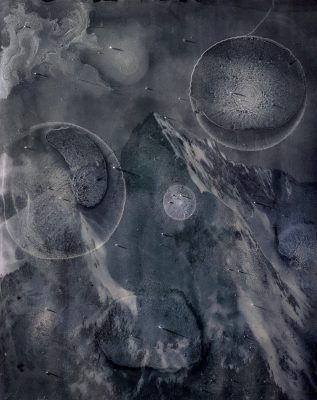
Does the mountain have a memory, 2023
archival pigment print, glass, wooden frame
105 x 84 cm
Does the mountain have a memory is the title of a picture of a snowcapped mountain. But Puranen has given it new character and texture. We can see what looks like little snowflakes dotting the surface of the picture and casting their shadows. All over the picture, there are drops that look like craters and amorphous splashes that seem to blend to form the grey other-worldly sky. In this picture, I feel the cold and crescendo just before a snowstorm envelopes the world. The picture is in the grip of frostbite. Does the mountain have a memory. What is this title referencing? Perhaps a time before the major biodiversity loss, before the hole in the ozone layer, before the melting of glaciers, before the Anthropocene. Perhaps the mountain can recall a different time. After all, it is much older than we.

Manic Meteors and Sleepy Planets, 2020
archival pigment print, diasec
70 x 70 cm
In Manic Meteors and Sleepy Planets, there is a vague outline of a circle, a planet?, and in the background the shadows of trees and their branches. Again, we have these little snowflakes casting their shadows across the planet and the trees. It feels like a meteor has exploded on the surface of this fruitful planet, or that we are seeing the life that the planet once fostered, but it is now long gone, leaving only shadows.
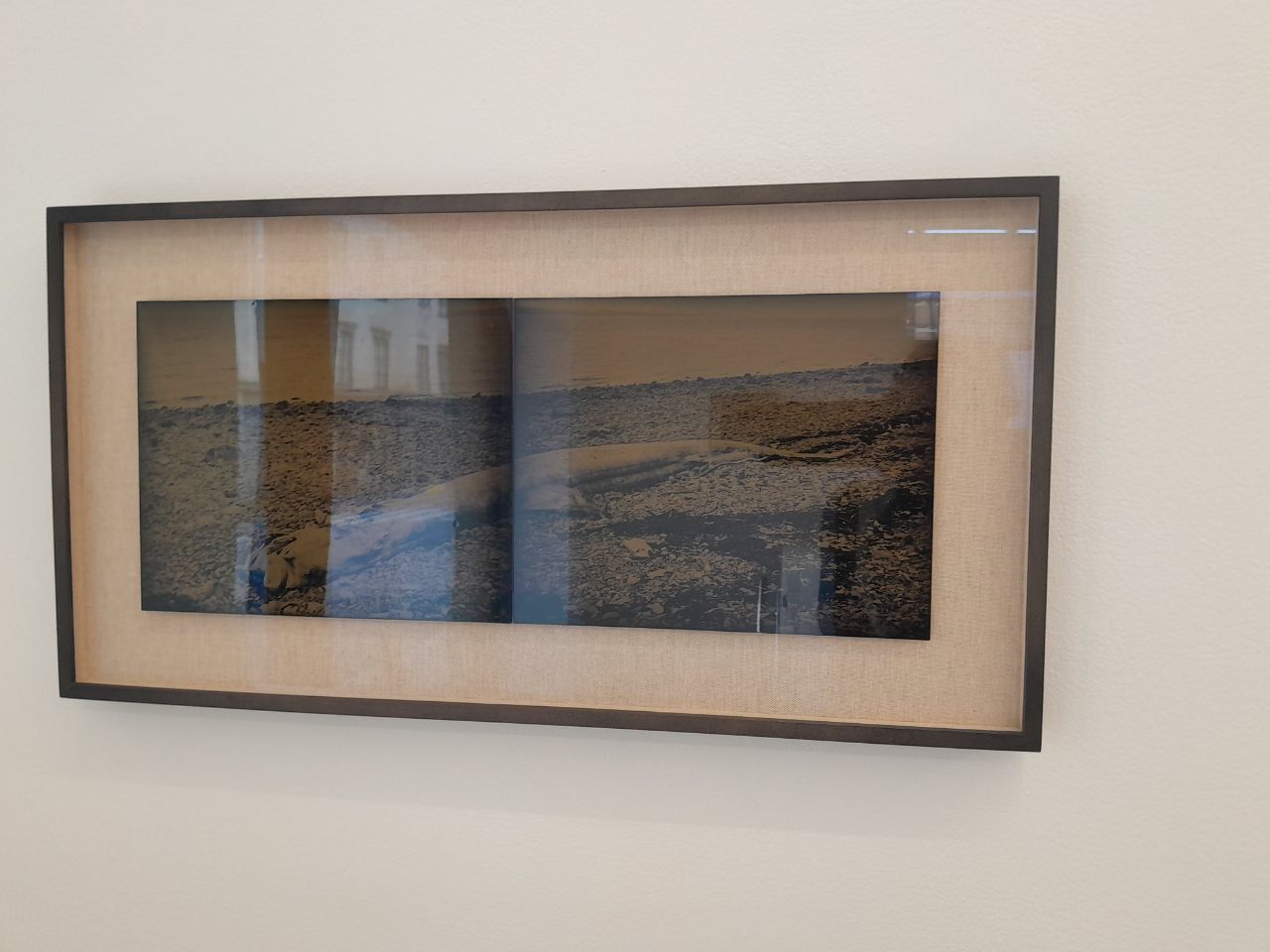
Arctic Shark
Arctic Shark is a brown, black, and grey picture of a sea animal dead on the shore. It is likely a Greenland shark, which is a species that is currently vulnerable as a result of human actions. Looking at the picture, I feel the discomfort that comes with beholding death. And I feel fascination at the otherness of this creature, and how little I know of it, and in extension how little we know of its home; the oceans that we treat as our dumping grounds or our pots of bounty. Ever-yielding.
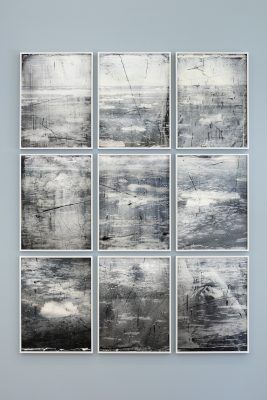
Horizon Variations (Isikajia), 2019
archival pigment print, glass, wooden frame
9 parts (á 61 x 46 cm)
189 x 144 cm
Horizon Variations (Isikajia) are 6 frames of what I assume are different perspectives from the mountain Isikajia in the Eastern Greenlandic settlement of Kulusuk. We see the sky and the sea on which ice floats in the first three frames, and in the middle three frames, more focus is given to the ice and the sea, same as in the last frames where we seem to get a close-up of the ice. The photos are bathed in white, reminiscent of ice and cold and snow, and there are dark scratches over the hazy photographs. We feel their age merely by looking at them. And again we have the shadows cast by the pieces of snow, as I like to call them, giving more volume to the picture. They are almost undetectable due to the busyness of the photos with the white light and scratches. In this series, Purranen shows us the spirit of the Arctic through his eyes.
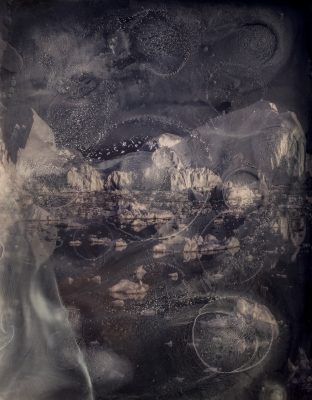
To the top of the mountains, to the ends of the world, 2022
Archival pigment print, glass, wooden frame
169 x 134,5 cm
To the top of the mountains, to the ends of the world reminds me of the human belief that we have conquered the earth, that we have gone to the tops of the mountains and the ends of our worlds. This is one about colonial history and Arctic exploration. This picture's subjects are the mountains, the sea, the ice, and the sky all encased in the difficult biome that is the Arctic. This represents all that we believe we have conquered by being a representation of one of the most difficult places to thrive on Earth. We have gone to the sea, mountains, forests, deserts, wetlands... we are the top dog on this planet. Yet this picture also reminds me of decay. The alterations that Puranen has made to this picture look like meteors, blasting away that belief.
Jorma Puranen's exhibition, They could hear a faraway thunder, is that faraway thunder. If one listens closely, one can hear the ice breaking, the oceans rising, and life in the far North and everywhere else changing as a result. If we all stood still, we would feel this thunder rattling our bones and shattering them to divine a prophecy. It says, there is a storm coming.
Author's Note:
I wrote this for Fine Art Analysis class. We went on a trip to the capital where we visited a lot of galleries and museums. We were told to write an analysis of one of the exhibitions we visited. I chose Jorma Puranen because the pungency of his technique stuck with me. I hope you enjoyed this. All the pictures were gotten from Galerie Anhava's page on the exhibition, except the Arctic Shark which was hastily taken on my phone. What do you think of his work?
Bạn đang đọc truyện trên: AzTruyen.Top